sábado, 20 de junio de 2020
El arte y las recomendaciones sanitarias
Un artículo sobre el arte y el diseño en tiempos de cuarentena y las imágenes que algunos gobiernos han elegido para transmitir ciertas recomendaciones sanitarias como la distancia social, el uso de gel para manos, mascarillas, pago con tarjeta...
https://courbettmagazine.com/arte-y-publicidad-contra-el-coronavirus/
Etiquetas:
artículos prensa,
proceso creativo,
vida cotidiana
lunes, 15 de junio de 2020
La senda botánica. Parque Forestal de Valdebernardo
Esta mañana he recorrido la senda botánica del Parque Forestal. Hacía meses que no caminaba por allí y lo primero que me ha llamado la atención es la desaparición de los carteles que había al pie de cada especie para que los paseantes pudieran saber su nombre.
Así que en vez de aprender a identificar nuevas especies me he dedicado a reconocer árboles o plantas que ya he visto otras veces en anteriores paseos.
Los eucaliptos son los que más han crecido desde la apertura del Parque. Hay un pequeño bosquecillo cerca de la entrada de Faunia.
Hojas jóvenes de eucalipto
Hojas de higuera
Hojas de liquidambar
Amapola blanca
Santolina
Flores de adelfa
Etiquetas:
árboles,
botanica,
fotografía,
simplicity,
vida cotidiana
domingo, 14 de junio de 2020
Sendas botánicas en el Parque Forestal.
Aunque en este Parque Forestal hay una senda botánica con 50 especies de árboles y arbustos hoy he caminado sin rumbo fijo, fijándome en los árboles que encontraba a mi paso.
Muchos estaban en flor o con frutos todavía inmaduros. El primero ha sido un nogal, el siguiente un fresno, después un olivo junto a varias filas de viñas.
Más allá he descubierto varias filas de perales. Unos almendros. Y finalmente lo que me han parecido tilos en flor...
Y unas flores amarillas que creo que son aquileas. O mielenrama.
nogal
fresno
viñas
peral
aquileas
almendros
tilos en flor
Etiquetas:
árboles,
botanica,
proceso creativo,
vida cotidiana
sábado, 13 de junio de 2020
Opening heart yoga. Cindy Lee
Ocho sencillas posturas para "abrir" el corazón
En sánscrito la palabra para corazón es hridayam que significa el que recibe, da y circula. Al fortalecer brazos, costillas, hombros, cuello, espalda y pecho podemos mejor el movimiento en todas esas áreas.
Esta vinyasa es una secuencia fluida de movimientos y la secuencia debe repetirse al menos cuatro veces, tratando en cada una de ellas de observar la respiración y los cambios que se producen al cabo de los días.
The Sanskrit word for heart is hridayam, meaning “that which receives, gives and circulates.” We can increase this process of giving, receiving and circulating by strengthening the supportive and protective anatomy around our heart and extending the range of motion in those areas. That includes our arms, ribcage, shoulders, neck, upper back and chest.
Let’s try the following vinyasa, or flowing sequence of movements. It will deepen your awareness of these areas and allow your life prana to flow without obstruction. Work gently, mindfully, and rhythmically. I have included breathing guidelines, but it’s fine if you wish to stay in each position for longer than one breath.
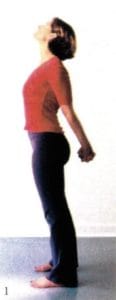
1. Begin by standing with your feet about hip distance apart. Clasp your hands together behind your back. (If you can’t reach, you can hold on to a belt or towel.) Try to lift the front of your armpits so your shoulders are not rounding forward. Draw your shoulder blades toward each other and feel broad across the collarbones. Inhale.
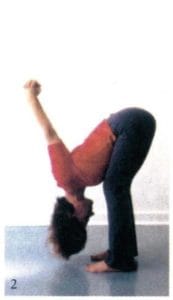
2. Exhale and fold your upper body over your legs. Your arms will go over your head, but try to stay open across the chest. Let your head be heavy and your neck long. If you feel any strain on the back of the legs or your back, bend your knees. Over time your muscles will lengthen and you will be able to straighten your legs easily, but in the meantime, work mindfully and don’t even consider pushing your body.

1. Begin by standing with your feet about hip distance apart. Clasp your hands together behind your back. (If you can’t reach, you can hold on to a belt or towel.) Try to lift the front of your armpits so your shoulders are not rounding forward. Draw your shoulder blades toward each other and feel broad across the collarbones. Inhale.

2. Exhale and fold your upper body over your legs. Your arms will go over your head, but try to stay open across the chest. Let your head be heavy and your neck long. If you feel any strain on the back of the legs or your back, bend your knees. Over time your muscles will lengthen and you will be able to straighten your legs easily, but in the meantime, work mindfully and don’t even consider pushing your body.
3. From here, release your arms and place your fingertips on the floor, directly below your shoulders. On an inhale, lift your chest so your spine is parallel to the floor. Feel how the inhalation lifts your heart to this position. Again, bend your knees if that is more comfortable.
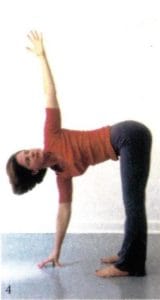
4. As you exhale, twist to the right and reach your right arm up to the ceiling. Look up at your hand. If it is in the correct position, it will look as if it’s over your mouth. Feel the right side of your belly spinning up to the sky. Feel a broad line of energy connecting your two hands.

4. As you exhale, twist to the right and reach your right arm up to the ceiling. Look up at your hand. If it is in the correct position, it will look as if it’s over your mouth. Feel the right side of your belly spinning up to the sky. Feel a broad line of energy connecting your two hands.
5. Inhale, and return to the flat back position. As you exhale, twist to the other side. Look up and feel the opening in the front of your left armpit/chest area. Inhale and return to flat back.
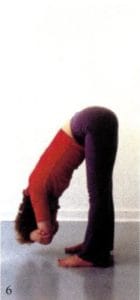
6. Exhale, and fold over your legs. Hold onto your elbows and let your head drop. Feel your upper body cascading like a waterfall out of your strong legs which are rooted to the earth. Stay here for a few breaths, or as long as you like.

6. Exhale, and fold over your legs. Hold onto your elbows and let your head drop. Feel your upper body cascading like a waterfall out of your strong legs which are rooted to the earth. Stay here for a few breaths, or as long as you like.
7. When you are ready, on an inhale, begin to round up through your spine. Continue to hold onto your elbows, so that when you are all the way up, your arms will be framing your face. See if you can stand with your arms in this position without letting your front ribs stick out. Relax the whole front of your body and feel it relating to the back of your body. Visualize your warm exhalation moving in a circle around the entire ring of your neck.
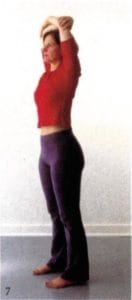
8. On your next inhalation, lengthen your arms overhead, and as you exhale, bend to the right. Feel your breath moving into the left side of your rib cage as it fans open like an accordion.
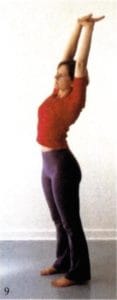
9. Inhale back up to standing and exhale over to the left. Now fill the right side of your ribcage with nourishing breath. Try to keep both arms straight. Press the soles of your feet into the earth. Let your in-breath lift you back up to standing.

8. On your next inhalation, lengthen your arms overhead, and as you exhale, bend to the right. Feel your breath moving into the left side of your rib cage as it fans open like an accordion.

9. Inhale back up to standing and exhale over to the left. Now fill the right side of your ribcage with nourishing breath. Try to keep both arms straight. Press the soles of your feet into the earth. Let your in-breath lift you back up to standing.
Repeat this sequence at least four times. Stay connected to the movement of the breath as much as possible by following the path of the breath with your mind. Start to notice where it goes and where it doesn’t. Notice what’s available to you today and how it’s different in each position.
On your third and fourth sets, see if you can deepen your breathing slightly, without straining or pushing. Maybe you can and maybe you can’t—it doesn’t matter. Just see what you can learn about yourself. Then practice it again tomorrow and see how it’s different. The main thing is to stay present with the exercise and not get hard in your mind, body or breath.
Your body, your shoulders, arms, neck and ribs, can be either a restrictive cage for your heart or an undulating, comforting protector. Well-known yoga teacher Rodney Yee once asked a class, “If you could hold your heart in your hands, how would you hold it?” Ask yourself how you are holding your heart right now: Tightly, tenderly, firmly, gently, carefully, attentively, fearfully, tentatively, easily, joyously?
Chögyam Trungpa Rinpoche said, “The way to rule the universe is to expose your heart.” When the ebb and flow of our heart diminishes, we feel separate from the vast world around us, a world in which everything breathes, pulsates, expands and contracts. Yoga, Buddhism and all spiritual paths are a map showing the journey back to the heart of the universe: Big Mind, Great Spirit, the Source of all that is. And the heart of the universe is, of course, always within our own hearts, if only we can be brave enough to feel its movement.
Etiquetas:
bienestar,
budismo,
emociones,
simplicity,
vida cotidiana,
yoga
jueves, 11 de junio de 2020
La hora de los hipócritas. Petros Markaris
Markaris habla de la realidad de su país, Grecia, a través de un personaje de novela negra, Kristos Jaritos, un policia de cierta edad que ha conseguido un ascenso largamente esperado y que tiene que enfrentarse a la resolución de crímenes muy relacionados con la política griega de los últimos tiempos.
En la última, por ahora, entrega de esta serie veremos como distintos personajes acomodados y bien considerados socialmente son asesinados ante la sorpresa y conmoción general. Poco a poco descubriremos que su imagen pública tenía poco que ver con la realidad. Las pesquisas policiales llevaran a los responsables de estos ataques a ciudadanos muy respetados hasta entonces y que resultarán ser hipócritas y poco escrupulosos.
En una reciente entrevista Markaris comenta irónicamente como en estos momentos todos alaban la gestión griega de la pandemia, ejemplar por la colaboración de todos los partidos y recuerda las críticas recibidas durante los años de la crísis y gestión que Europa hizo de las ayudas en aquel momento.
https://www.eldiario.es/cultura/Markaris-elogian-Grecia-pusieron-picota_0_1024348294.html
En la última, por ahora, entrega de esta serie veremos como distintos personajes acomodados y bien considerados socialmente son asesinados ante la sorpresa y conmoción general. Poco a poco descubriremos que su imagen pública tenía poco que ver con la realidad. Las pesquisas policiales llevaran a los responsables de estos ataques a ciudadanos muy respetados hasta entonces y que resultarán ser hipócritas y poco escrupulosos.
En una reciente entrevista Markaris comenta irónicamente como en estos momentos todos alaban la gestión griega de la pandemia, ejemplar por la colaboración de todos los partidos y recuerda las críticas recibidas durante los años de la crísis y gestión que Europa hizo de las ayudas en aquel momento.
https://www.eldiario.es/cultura/Markaris-elogian-Grecia-pusieron-picota_0_1024348294.html
Etiquetas:
artículos prensa,
escritores,
libros,
Los años oscuros ¿vuelven?,
series,
vida cotidiana
sábado, 6 de junio de 2020
Lascia ch'io pianga (Händel's opera Rinaldo); Voices of Music with Kirst...
George Friedrich Händel - Lascia ch'io pianga mia cruda sorte, from Rinaldo, opera, HWV 7, 1711 | Philippe Jaroussky, 2016. "Lascia ch'io pianga mia cruda sorte, e che sospiri la libertà. Il duolo infranga queste ritorte de' miei martiri sol per pietà. "Let me weep over my cruel fate, and that I may sigh for freedom Let my sadness shatter these chains of my suffering, if only out of pity.
Etiquetas:
mourning,
música para...,
simplicity,
vida cotidiana
jueves, 4 de junio de 2020
Consumimos el dolor ajeno pero no soportamos el propio. Las pasiones de la modernidad
Recuerdo escuchar a alguien que decía que el dolor más fácil de soportar es siempre el dolor ajeno.
Una entrevista de hace unos años, que habla de las pasiones de la modernidad y del dolor, a un profesor universitario, Javier Moscoso, que publicó entonces una "Historia cultural del dolor
..." Al igual que existía en la Edad Media, ahora existe un consumo muy grande de dolor ajeno y una notable (y esto no existía en la Edad Media) falta de resistencia ante el dolor propio. Es decir: se consume tanto el dolor ajeno como se pretende evitar el propio con un uso masivo de fármacos.
-P: Si tuviera que hacer una radiografía del dolor del español actual, ¿Cuál podría ser? ¿Cuáles son los temas que nos causan más dolor a los españoles?
-R: Mi impresión es que el mayor problema sigue siendo la injusticia, a todos los niveles. Y esto lo que yo creo que produce un desencanto tanto desde punto de vista social como político. Se puede aceptar el dolor cuando va regulado o va seguido por una situación de esperanza, o bien se considera que es inevitable, pero lo que se tolera muy difícilmente es el dolor que se considera injusto o evitable.
Y desde el punto de vista político y social, es difícilmente tolerable la injusticia presente todos los días en los medios de comunicación, bien sea en casos de corrupción o en otro tipo de asuntos de naturaleza más social aflora permanentemente. En realidad nuestro mundo contemporáneo podría ser perfectamente definido como un ansia permanente de justicia.
-P: ¿Y cuáles son las pasiones de la modernidad, un tema en el que ha trabajado durante los últimos años?
-R: Las pasiones en las que yo trabajo son sobre todo pasiones de la rivalidad como la ambición, la envidia, los celos, el resentimiento… Son pasiones que en general van ligadas a la ambición, no tiene, por qué ser necesariamente emociones o pasiones negativas, que han tenido un exponente a lo largo de nuestro mundo contemporáneo. Estas son algunas de las pasiones de la modernidad, lo cual no quiere decir que no existieran antes, sino que han eclosionado y conquistado la forma en la que se construye el mundo contemporáneo.
-P: ¿Qué mueve más a la humanidad el amor o el odio?
-R: Prefiero pensar que el amor, por eso me da la impresión de que a pesar de todo, en algunas cuestiones se avanza, aunque el odio está muy presente y hay comportamientos humanos que no pueden explicarse desde ningún otro punto de vista.
-P: ¿Es la indignación una seña de identidad de la sociedad actual?
-R: Sí, la indignación es una seña de identidad del mundo contemporáneo a partir del momento en el que hay un conjunto de promesas, que establece ya la Revolución Francesa, que son promesas incumplidas. Tienen que ver con una mayor democratización de los Estados, una mayor igualdad, ausencia de la injusticia que supone que la procedencia, la geografía, o el oficio de los padres influya en los desarrollos y las recompensas que tienen los seres humanos. Todo esto, como se sigue comprobando hoy en día, han sido promesas rotas la mayor parte de las veces.
La idea tan meritocrática, de que podíamos llegar a una sociedad justa en sus fines y ética en sus medios, se ha visto desbaratada muchas veces. Así pues, la indignación o el resentimiento es una opción emocional y política, que aflora en distintos momentos de la historia. Ahora vemos, hemos visto y seguimos viendo uno de ello
https://edit.um.es/campusdigital/javier-moscoso-existe-un-consumo-muy-grande-de-dolor-ajeno-y-una-notable-falta-de-resistencia-ante-el-dolor-propio/
Etiquetas:
artículos prensa,
cambiar el mundo,
emociones,
escritores,
filosofía,
los indignados,
vida cotidiana
Suscribirse a:
Comentarios (Atom)


























